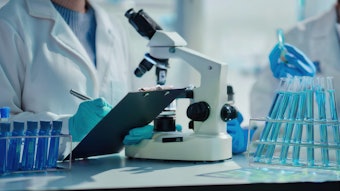- Urged on by macro consumer trends of health and wellness and eco-friendliness, beauty ingredient suppliers are more often looking to nature for their new product inspirations and solutions.
- Seeking out natural ingredient solutions is nothing new, but suppliers can now look deeper into natural ingredients for more effective, well-honed solutions.
- Biomimicry is a growing ingredient trend in which companies apply knowledge acquired from nature to create practical ingredient applications.
- Scientific advances at a nanoscale allow the industry to innovate in groundbreaking ways.
In today’s beauty industry, product developers and brands are increasingly looking to nature for inspiration. This is likely because nature, for the most part, has already perfected its ingredients, as well as its natural chemical, engineering and structural processes.
“There is a definite move toward wellness and environmentally friendly ingredients, even sourcing directly from nature,” says Darrin Duber-Smith, president, Green Marketing Inc. The health and wellness trend is now mainstream, making bio utilization key to the success of many brands. Also, there’s a lot of perceived danger and bad press about problematic chemicals, and the pressure for cosmetics to go green is at an all-time high. At the same time, consumers buy benefits, not features. “It’s less now about the ingredients and more about their function,” explains Duber-Smith.
But why stop there? Technology emulating nature has resulted in innovations that make consumers’ lives easier, healthier and more sustainable. The emerging field of biomimetics has given rise to new technologies created from biologically inspired engineering on both the macroscale and nanoscale levels. And it also makes for a good marketing story in today’s eco-friendly marketplace.
Biomimetics is not a new idea. Humans have been looking at nature for answers to both complex and simple problems since the beginning. But biomimicry is a relatively new corporate discipline that studies nature’s best ideas and then imitates these designs and processes to solve today’s problems. There is potential to replicate nature’s intelligence to produce ingredients that are safer or better for consumer use and not harmful to the environment.
Bio-utilization
Identifying and studying natural active materials to serve as alternatives to problematic chemicals has long been a core philosophy at CoValence, and traditionally, this concept catered to a niche crowd. However, today’s consumers are far more educated to the effects of harsh chemical materials.
Consumers have clearly stated that the products they use must be more and more natural while also delivering on the performance claims they make. It’s about providing options. “Today’s natural products work better,” explains Duber-Smith. “We don’t have to sacrifice functionality for natural anymore.” But there are still improvements to be made. From emollients and surfactants to preservatives and beyond, consumers want the function without sacrificing the aesthetics and experiences associated with their beauty products.
In its efforts, CoValence looks for ways to boost the efficacy of plants typically found in natural products for more reliable results. Certain species of plants like green tea, aloe vera and various berries all contain active chemical compounds that are unique to their respective biology. For example, green tea’s activity is attributed to a molecule called epigallocatechin gallate (EGCG) and berries get their antioxidant power from a class of compounds called anthocyanins.
“Formulations can harness this simple fact, as it’s been proven that the addition of a plant’s active molecule in addition to an extract of the host plant will outperform formulations that contain an extract of the host plant alone,” says John Stanek, manager of new technologies and purchasing, CoValence. Presently developing ingredient products with most of the traditional plant’s active molecules, CoValence is also continually researching and testing new plant molecules.
The company also aims to master the science of encapsulation in the coming year. Encapsulation methods have been used in the pharma industry for decades, and the ability to stabilize an unstable compound or increase its penetration ability and subsequent activity is of interest to many in the beauty industry. Stanek envisions traditional actives with custom-tailored encapsulation systems capable of providing dramatic boosts in efficacy, compared to their non-encapsulated counterparts. “Our research groups have successfully developed a series of prototypes that are currently in late-phase testing and are showing much promise in making our dream a reality,” he explains.
Biomimicry
The difference between bio-utilization—using biological ingredients—and biomimicry is in learning what nature’s recipes are and applying them to your processes. Biomimicry provides a strategy for practical applications that emulate what nature has perfected. “We look to see how nature has solved the myriad problems that exist in their world,” says Mark Dorfman, a green chemistry naturalist. “By breaking down the problem to identify the key function of the problematic chemical, we can then begin to search nature for where we see a similar function,” explains Dorfman. “By opening the possibilities through nature, strategies and mechanisms become available that you didn’t even know could exist.” That’s the biomimetic process.
According to the newly formed conglomerate Biomimicry 3.8, the biomimicry field has changed at a stunning pace in recent years. In light of scientific advances, the technology to study nature and its chemistry at a depth and detail not possible in the past is now available. From ingredients that protect cellular DNA by increasing its Hayflick limit to those that increase the concentration of homogeneity of chromophores, new concepts that push the limits are based on intricate knowledge gained by taking a closer look at natural processes.
Mibelle is currently evaluating the possibility of biomimetic epidermal-to-dermal cell communication as a new anti-aging concept to achieve beneficial effects in the deep layers of the skin. “Current actives penetrate only into the superficial skin layers. Therefore, the activity of active ingredients to the deeper layers is really limited,” explains Fred Zülli, Mibelle Biochemistry. To address this issue, the company uses a novel concept based on the communication activities of cells, called cell signaling. Activating keratinocytes at the skin’s surface to release signals to stimulate fibroblasts activates the collagen and elastin, even though they cannot penetrate deep into the skin themselves. With the concept of epidermal-dermal cell communication, beauty products can be formulated that have a much faster and more efficient effect on the dermis and, therefore, will target the rejuvenation of deep wrinkles.
“The need to address deeper skin layers is obvious,” says Zülli. “But the idea to use biomimetic signaling as a new tool was our breakthrough.” Recent scientific literature showed there are a large number of molecules, such as growth factors and cytokines, that are involved in epidermal-dermal communication. “The limitation of the concept is to find active ingredients based on natural sources, which can stimulate the right release of signal factors from keratinocytes,” Zülli says.
Such scientific advances at a nanoscale—resulting only from a unique understanding of the inner workings of cells—allow the industry to innovate in groundbreaking ways.
And Beyond
Not only does nature survive, even thrive, it meets challenges without poisoning its environment. “Sustainability is the idea that we can have a modern society that fits into nature,” says Dorfman. Nature has to find, manufacture and dispose of its resources in the same place. It’s the ideal source for functional, nontoxic solutions.
One example outside the beauty industry is Columbia Forest Products. The company was having a problem with composite wood products. The glue being used was off-gassing formaldehyde, impacting air quality and making people sick from the fumes. Looking to nature for answers, one scientist studied how blue mussels stick themselves to rock. Eventually, they were able to develop a benign, waterproof adhesive based on soy protein.
The lesson, according to Dorfman, is that they looked at the chemical structure and formula of the adhesive and mimicked the chemistry with the soy protein. “They learned the recipe and adapted it to make something effective and nontoxic without wasting resources by harvesting the blue mussel itself,” he explains. “Nature is a good source for inspiring innovative and effective solutions to our toxic chemical challenges.” In some cases, the result can be an even purer product for the end consumer.
To address the issue of toxic heavy metals or toxic organic compounds associated with some pigments, EMD Chemicals, a division of Merck KGaA, Darmstadt, Germany, has introduced synthetic mica pigments in several colors and has another seven coming this year. The pigments are reproductions, using synthetic fluorphlogopite and iron oxides. As they are made synthetically and not mined, these affordable pigments have a very low heavy metal content, providing a cleaner and whiter base for pigments.
Phil Linz, EMD’s applications supervisor, is impressed by how quickly the company is moving on the idea. “Both EMD and our parent company are committed to this concept,” he says. Natural pigments have impurities and heavy metals such as iron oxides that dull the mica. “We get our material from a number of mines around the world. If we could increase reproducibility, our customers would appreciate that in the long run,” Linz notes.
Of course, the solution is not always what you might think it should be. The answer may not be a chemical solution, replacing a toxic ingredient with a less toxic one, for example. It may be a structural or engineering concept instead.
Nature makes color with pigment, right? Not always. The wings of many brightly colored butterflies are not pigmented. They obtain their color by physically manipulating light. The photonic structures present on their surface selectively reflect certain frequencies of light, with extreme specificity and efficiency. Like soap bubbles or seashells, they often have a dramatic color shift quality that can be mimicked with unique, multilayer, submicroscopic layers that similarly play with spacing or wavelengths to give off different colors.
“What is so exciting about biomimicry is that when you have no idea what to do about a problem, it opens a whole new solutions space, allowing you to think outside the box,” says Bryony Schwan, executive director of Biomimicry 3.8, which works with companies to solve specific design challenges and to rethink how they do business at a more sustainable level.
Schwan and her colleagues see manufacturers from across industries frustrated because they are using chemicals that have adverse effects. They want to respond to those advocating for alternatives, but they don’t always know where to turn. Biomimicry is a solution space that is being turned to more often. “We understand what some of the challenges are and have had success looking to nature to find solutions,” says Schwan.
Biomimicry 3.8 encourages companies not to be limited by which problems are most amenable to a biomimetical solution. “Any problem can be addressed,” comments Dorfman. “Start with those that are causing the biggest known health effects or the biggest impact to your product in a positive way.”
One of the industry’s biggest concerns is preventing contamination and controversy over preservative use, as well as the alternatives to parabens. Antimicrobials are often toxic and promote bacterial resistance. However, nature itself has many different antibacterial strategies. The red seaweed Delisea pulchra, for example, doesn’t have a slimy surface from bacteria like others. It uses natural chemicals—furanones—to effectively avoid bacterial infections altogether. The furanones repel bacteria, interfering with cell-to-cell communication that allows the bacteria to form and maintain biofilms, without breeding any bacterial resistance to its defensive chemistry.
There also has been a synthetic surface developed by Sharklet Technologies, for possible packaging solutions. Inspired by the skin of the Galapagos shark, which is structured such that bacteria cannot adhere to it, the artificial surface works without killing microbes. Similar to the seaweed, there is no selection for resistance. Nature indeed has elegant engineering solutions.
Building Better Beauty
It is the responsibility of all to use ingredients that are safe. Safe for consumers and, by way of consumer demand, safe for the environment. Any opportunity for companies to solve problems or innovate new products without toxicity or environmental side effects is good for business and the industry. It also helps companies develop an interesting and engaging story to tell their customers, which also provides a new way to develop a closer consumer connection.
Sara Mason is a freelance writer based in the Chicagoland area. She was previously managing editor of GCI magazine.










